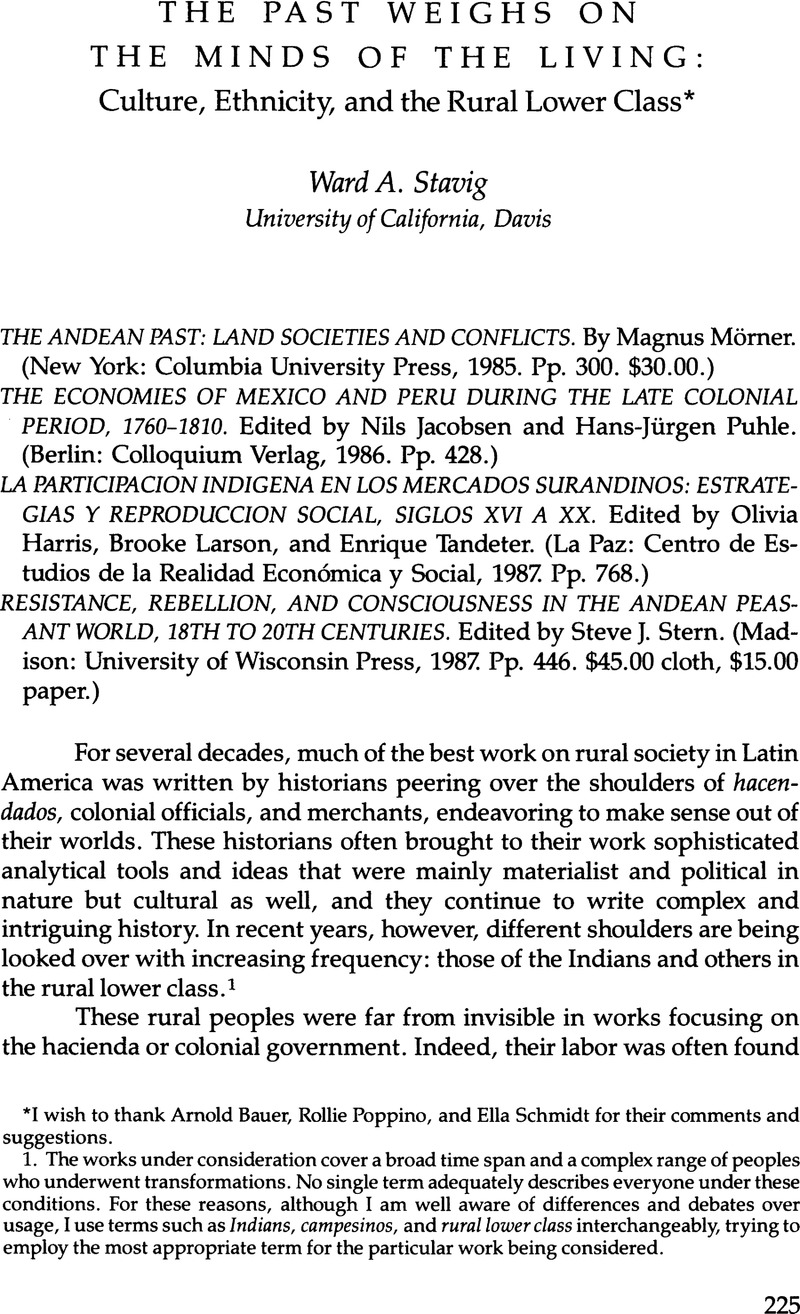Published online by Cambridge University Press: 12 October 2022

I wish to thank Arnold Bauer, Rollie Poppino, and Ella Schmidt for their comments and suggestions.
1. The works under consideration cover a broad time span and a complex range of peoples who underwent transformations. No single term adequately describes everyone under these conditions. For these reasons, although I am well aware of differences and debates over usage, I use terms such as Indians, campesinos, and rural lower class interchangeably, trying to employ the most appropriate term for the particular work being considered.
2. Brooke Larson, “‘Exploitation’ and ‘Moral Economy’ in the Southern Andes: A Critical Reconsideration.” Paper presented at the conference of the Consejo Latinoamericano de Ciencias Sociales (CLASCO), 26–29 June 1986, 27
3. Karl Polanyi, The Great Transformation (New York: 1944), 46.
4. John Womack, Zapata and the Mexican Revolution, (New York: Random House, 1969), x.
5. E. P. Thompson, “The Moral Economy of the English Crowd in the Eighteenth Century,” Past and Present 50 (Feb. 1971):76–136; James L. Scott, The Moral Economy of the Peasant: Rebellion and Subsistence in Southeast Asia (New Haven, Conn.: Yale University Press, 1976). For the Andes, see Brooke Larson, “‘Exploitation’ and ‘Moral Economy’ in the Southern Andes”; Erick D. Langer, “Labor Strikes and Reciprocity on Chuquisaca Haciendas,” Hispanic American Historical Review 65, no. 2 (May 1985):255–77; and Ward Stavig, “Ethnic Conflict, Moral Economy, and Population in Rural Cuzco on the Eve of the Thupa Amaro II Rebellion,” Hispanic American Historical Review 68, no. 4 (Nov. 1988):737–70.
6. Stavig, “Ethnic Conflict, Moral Economy,” 739–40.
7. On the erosion of curaca power in the late eighteenth century, see David Cahill, “Curas and Social Conflict in the Doctrinas of Cuzco, 1780–1814,” Journal of Latin American Studies 16, pt. 2 (Nov. 1984):241–76. For dual relationships in the moral economy, see Stavig, “Ethnic Conflict, Moral Economy.”
8. David A. Brading and Harry E. Cross, “Colonial Silver Mining: Mexico and Peru,” Hispanic American Historical Review 52, no. 4 (Nov. 1972):545–79. For the sake of convention, I have left the title of the rebellion in the more common Spanish spelling, Tupac Amaru. For the correct spelling of the revolutionary's name, see John H. Rowe “Thupa Amaro: nombre y apellido,” Boletín de lima 4, no. 24 (Nov. 1982):6–9.
9. Norio Yamamoto, “Papa, llama y chaquitaclla: una perspectiva etnobotánica de la cultura andina,” in Recursos naturales andinos, edited by S. Masuda (Tokyo: University of Tokyo, 1988?). Some very interesting work is being done related to use of animals in the productive process. For example, see Arnold J. Bauer, “La cultura mediterránea en las condiciones del nuevo mundo: elementos en la tranferencia del trigo a las Indias,” Historia 21 (1986):31–53 (published by the Universidad Católica de Chile).
10. Robert Ricard, The Spiritual Conquest of Mexico (Berkeley and Los Angeles: University of California Press, 1966). Also, Anita Brenner, Idols behind Altars: The Story of the Mexican Spirit (Boston, Mass.: Beacon, 1970).
11. Two examples of such works outside the Latin American context are Eugene D. Genovese, Roll, Jordan, Roll: The World the Slaves Made (New York: Pantheon, 1974); and James Scott, Weapons of the Weak: Everyday Forms of Peasant Resistance (New Haven: Yale University Press, 1985).
12. Ward Stavig, “Amor, sexo y violencia sexual en las comunidades del Cuzco rural: un estudio de los valores indígenas en la sociedad colonial,” manuscript.
13. Roger Neil Rasnake, “Kurahkuna of Yura: Indigenous Authorities of Colonial Charcas and Contemporary Bolivia,” Ph.D. diss., Cornell University, 1982, 187–88. See also Stavig, “Ethnic Conflict,” 766.
14. Magnus Mörner and Efraín Trelles, “Un intento de calibrar las actitudes hacia la rebelión en el Cuzco durante la acción de Túpac Amaru,” Estudios Históricos sobre Estructuras Agrarias Andinas, no. 2 (Mar. 1985). This journal is published by the Institute of Latin American Studies in Stockholm.
15. Karen Spalding, De indio a campesino: cambios en la estructura social del Perú colonial (Lima: Instituto de Estudios Peruanos, 1974); and William B. Taylor, “Banditry and Insurrection: Rural Unrest in Central Jalisco, 1790–1816,” in Riot, Rebellion, and Revolution: Rural Social Conflict in Mexico, edited by Friedrich Katz (Princeton, N.J.: Princeton University Press, 1988), 231–32.
16. “Peruvian Farmers Said to Kill Rebels,” New York Times, 4 Mar. 1990, p. 13.
17. The quotation is from Campbell, but Flores Galindo, Stern, and Szeminski all mention Inkarrí.
18. In the introduction, Stern refers to the “universal” nature of the movements, but he may mean merely that they were widespread and that Europeans could also believe in them. Alberto Flores Galindo wrote, “La utopía adquiere una dimensión panandina. … No creamos que todos están aguardando el regreso del inca. El territorio es dilatado pero no continuo: se trata más bien de islotes y archipiélagos. La idea no sólo se propala entre los indios: llega a criollos, españoles, nativos de la selva central, mestizos, pero no consigue la unanimidad, como es obvio.” See Galindo, Europa y el país de los Incas: la utopía andina (Lima: Instituto de Apoyo Agrario, 1986), 67.
19. Brading and Cross, “Colonial Silver Mining: Mexico and Peru.”
20. Gwendolin Cobb, “Supply and Transportation for the Potosí Mines,” Hispanic American Historical Review 29, no. 1 (1949):25–45; and Alberto Crespo Rodas, “La mita de Potosí,” Revista Histórica 22 (1955–56):169–82 (published in Lima).
21. J. R. Fisher, Silver Mines and Silver Miners in Colonial Peru, 1776–1824, Monograph Series, no. 7 (Liverpool: Centre for Latin American Studies, University of Liverpool, 1977), 2.
22. For a discussion of Indian transport in an earlier era, see the work of Luis Miguel Glave. A good work to begin with is Trajinantes: caminos indígenas en la sociedad colonial, siglos XVI–XVII (Lima: Instituto de Apoyo Agrario, 1989).
23. Gregorio Condori Mamani: autobiografía, edited by Ricardo Valderrama Fernández and Carmen Escalante Gutiérrez (Cuzco: 1977).